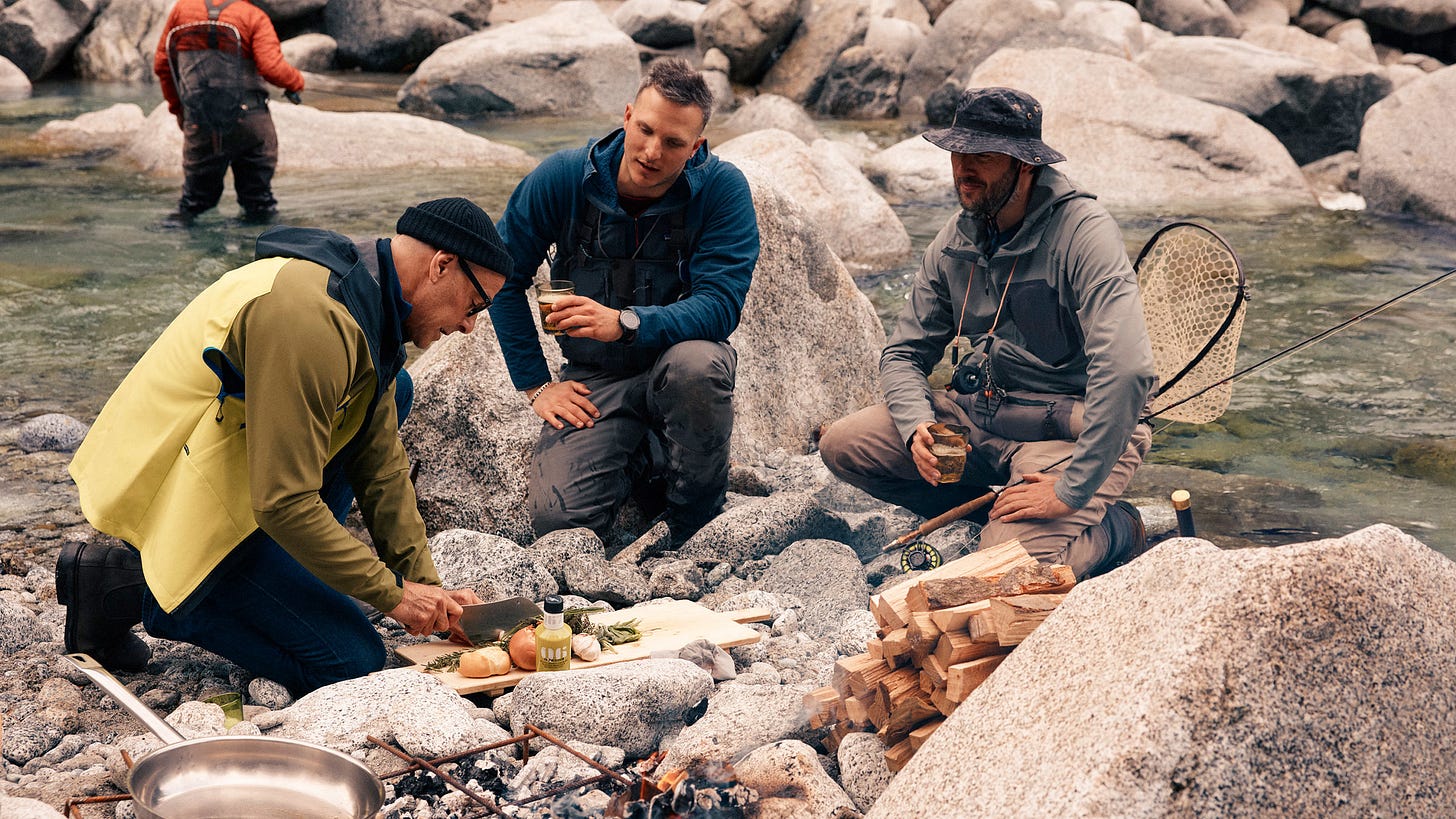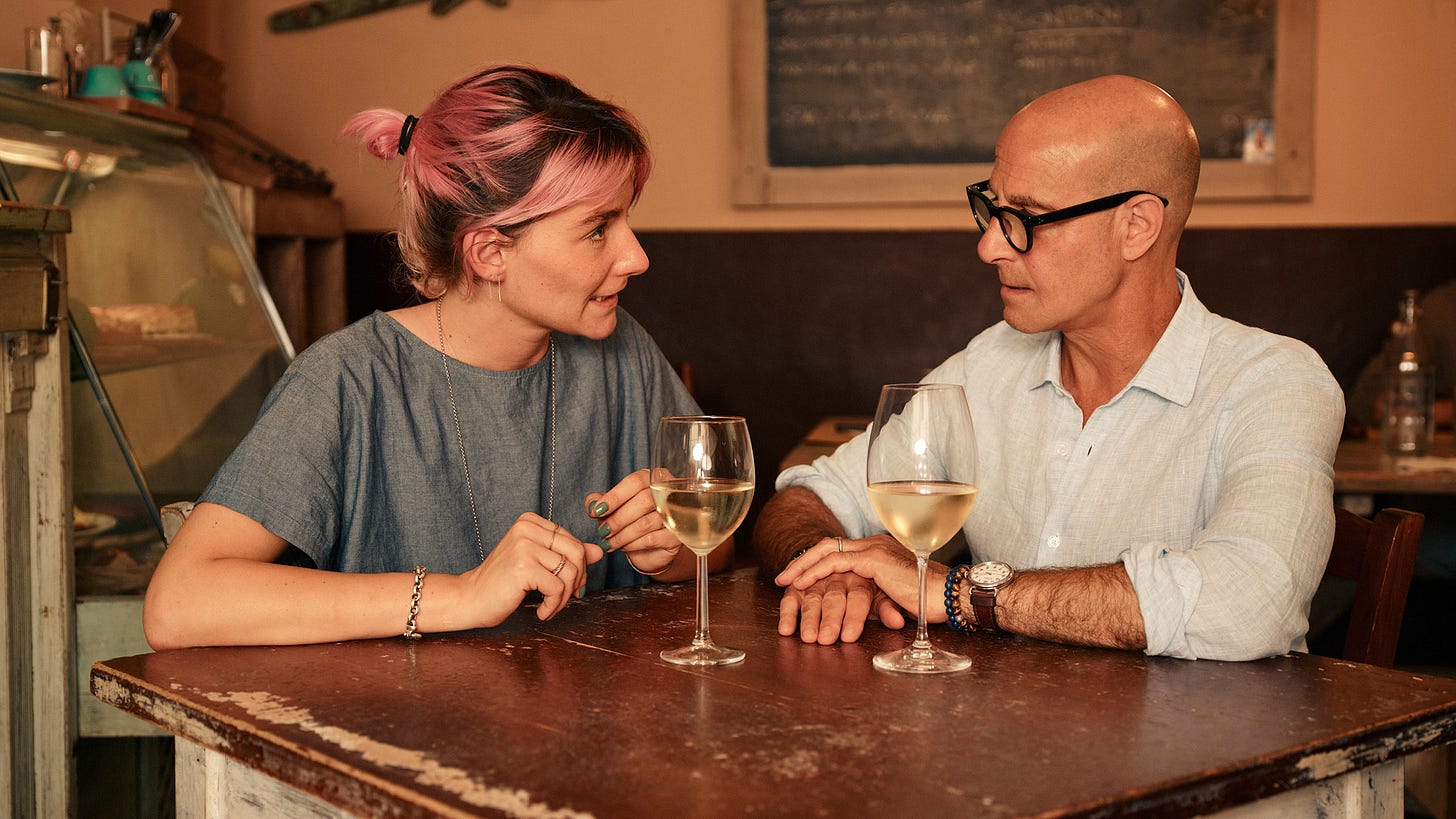I went ahead and binged Stanley Tucci’s new show last night
As soon as I saw Emiko Davies’s post about being a guest, I wanted to learn more about who else the writers recruited as local guides, what specialty ingredients/recipes would be featured and what the narrative would be for each region.

Like any travel show with a celebrity host and fat production budget, I expect the photography to be gorgeous, the aerial shots to be flawless, and the production to use their clout to request interviews with big name people and companies beyond what a “normal person” would be privy to. See Phil Rosenthal’s Somebody Feed Phil, and Zac Efron’s Down Under. As I wrote about in a previous newsletter, it feels as though Italy is being sold to the masses. I always worry that shows like this will add to the chaos and repetition of “classic” foods, beverages and cliche cultural experiences that take tourists farther down the rabbit hole of what Italy is not. See wine windows, and panini shops.
As a food industry professional, of course I enjoy watching travel shows set in Italy
After watching the entire season of Tucci in Italy once through, and then an extra time to research the details for this piece, I do think that Stanely and the writers did a very good job showcasing the nuances of the Italian food system while promoting ingredients, dishes, and food innovations; especially ones that are not rooted in technology. (Innovation can also mean bringing back traditions). Like the woman from Abruzzo bringing back the communal oven to her town (more on this below). Or romanticizing offal instead of the pristine cuts of meat. As Emiko Davies wrote on her own substack…
“And if more lampredotto stands open up — well, I for one would welcome more of this tradition, not only to keep alive a truly Florentine thing, but also perhaps it will even offset some of those bistecca restaurants.” - Emiko Davies, Notes from Emiko’s Kitchen
I think the same about ‘traditional’ Roman food - where four pasta recipes reign supreme. In the almost two years of living in Rome, I had carbonara maybe three times. Always inside the homes of families who wanted me to try their version. In reality, most of my lunches and dinners were supported by seasonal vegetables, beans of many kinds, and lots and lots of soups.
I am sad to report that no wineries were visted this season
No breweries either. But I didn’t have high hopes for that. It could be the network change from CNN to Nat Geo. Perhaps more family-friendly content was requested. However, a very special natural winery from Trevinano was featured in the Lazio episode (!) The name of the winery was omitted, but I am a good researcher. I knew from the moment the vino bianco was poured that it was not a commercial winery, the color contrast against the white table cloth & ceramic bowls gave away the fact that it was a white with bit more going on. When the winemakers were introduced as Simone and Giuliano, I knew it was Podere Orto.
I hope that future travel shows set in Italy will consider a tour to a natural winery and dive into more detail about the thriving sector, rather than just promote the assumption that wine is always made by the father or uncle of the shop owner. As for craft beer, Italy Segreta conveniently just published a comprehensive list of 20 of the Best Breweries in Italy, one from each region, for their sustainability issue. PS: I wrote it :) Boh, let’s see what happens with the next five episodes. Maybe craft beer is on the horizon.

Aside from food, I noticed hidden themes throughout the series that I believe highlight the real issues challenging Italy today, ones that tourists and perhaps, ambitious digital nomads using the country as a scenic backdrop to their above-average salary life, are not aware of. Here’s where I share them with you.
Lazio
In the Lazio episode, owners of Podere Orte, Simone and Giuliano and their daughter Maya share lunch over wine with Stanley and the chef team behind La Parolina, a one-Michelin star restaurant in Trevinano. When Maya was asked if she liked growing up in this small region, she said she loves going into the city of Rome, because of the variety of shops and international foods not avaliable in Trevinano. She recognizes how lucky she is to live in a beautiful place that not many people get the chance to see, but she foresees herself moving away and experiencing new things in new cities. Not an uncommon trope for young Italians.
As a 32-year-old who grew up surrounded by international food available at all hours of the day, and a Walmart or Target less than a bike ride away, I now crave the remote setting that Maya has; surrounded by natural spaces, quiet and the opportunity to make wine.
The larger issue remains that younger generations are seeking opportunities away from their small, hometown regions. Whether it be adventure fueled or career inspired. The narrative is perpetuated that Italian food, wine and culture is so revered because it is rooted in generational craftsmanship. But what if the younger generations want to pursue something different? This issue is discussed further in the Tuscany episode
Tuscany
Stanley visits a 11,000 acre, free-range cattle ranch in Maremma, where butteri (cattle ranchers) carry on the centuries old tradition of looking after an ancient Tuscan cattle breed.
The head buttero relays his concerns that the younger generations have little interest in learning specialized trades such as ranching. Young people are not taking over family farms, they are not swarming to work in the fields, or learn traditional methods of agriculture, and animal husbandry. These jobs are not easy, and they do not often pay well.
“You need to look for them with a magnifying glass.” The head buttero said. His speculation about if his current farmhand will still be there in a few years, was apparent. As I observed after working vendemmia in Le Marche, it’s hard to train someone new, year after year. Craftsmanship isn’t learned over a summer, but over generations.
These are the challenging realities Italy is facing. Yet, tourists continue to visit Italy season after season, ravenously eager to consume these specialty Italian products. But high-quality food takes patience, care and their production requires a skill set that cannot be learned in school, but rather apprenticeships, or better yet, through family teachings.
During my time in Rome, I saw that younger generations are relying more on convenient food through delivery apps, and pre-prepared food options, rather than learning how to cook from a parent or grandparent. The Abruzzo episode covers this phenomenon in more detail.
Abruzzo
In this episode, Stanley heads to Villa San Sebastiano. In 1955 a tragic landslide nearly destroyed the town but over the years, the residents have come together to rebuild. During the reconstruction of the town, the church was built first and then the communal oven. On my own trip to Abruzzo, I visited the town of Castel del Monte and learned about the importance of the communal oven, a once vital piece of this small village’s infrastructure. Communal ovens were a place for residents to come and use the roaring fire to bake bread for their home. (Logistically, large wood burning ovens are not a staple in small households.)
Then we meet Lucia, a chef who is now running the town’s communal forno, after being closed for 35 years. In the episode, she is shown teaching young children how to make bread, with messy, wet dough using only their hands, the way kids like to learn. She said that when she first turned the oven back on, no one in town came to use it, because none of the residents knew how to make bread. “Because today, everyone is comfy.” Lucia said. It’s true. There are shops that sell bread, conveniently and cheaply, even in small towns. But like Lucia explains, bread from the store will remain “fresh” for a day or two, while rustic bread, in this case bread with a local mountain wheat called Solina, will last over a week. It’s true. As an avid bread consumer I have tried all types of Italian bread and rustic bread made well, does last longer, and keeps you full for longer.
The immigrant/migrant moving to Italy narrative is a touchy subject, one that the late Anthony Bourdain tackled with veracity and poise. There are important features in almost every episode about one migrant story or another. However, writing about those topics would take another week to compile research alone. So I wanted to stop here. For now.
So what did we learn from the Tucci in Italy series?
I guess the answer will be different for everyone. That is one of the beautiful things about Italy, it has many sides. These are hidden themes that I found during my watch, maybe they are themes that have been in the back of my mind all along, and I just needed a jumping off point to write about them.

Extra thoughts:
I wonder if the fixers and writers for the new season of Emily in Paris set in Rome will discuss these paradoxes?
I also wonder which show has more influence? I guess we will see each other this summer.
Postscript
If you like what you read, PLEASE subscribe. Knowing that people are electively signing up to read my writing is the biggest compliment and encourages me to write more. I don’t plan on putting up a pay-wall at the moment, but anything helps as far as pledges go! A few generous readers have made an annual pledge and that support means the world to me. It helps me value my writing and my time as important, instead of feeling trapped behind a bar.
Thank you for reading,
Tana




I didn’t enjoy this season as much. I felt it lacked energy and personality.
I lived in Italy for a few years. Do you suggest watching?